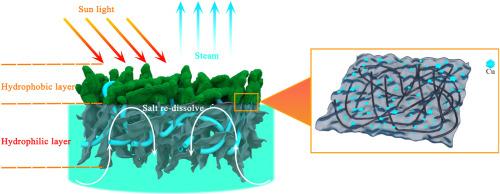具有自清洁能力的掺氮生物质碳气凝胶增强了铜等离子体效应
IF 11.6
2区 材料科学
Q1 CHEMISTRY, PHYSICAL
引用次数: 0
摘要
为了解决淡水短缺危机,本研究以工业级多壁碳纳米管(CNTs)为框架,用Cu纳米颗粒修饰上表面形成不对称结构,从而构建了基于生物质气凝胶的三维Janus太阳能蒸发器(Cu@CNTs-IP)。蒸发器通过三重协同机制实现性能增强:首先,CNTs的强光吸收与Cu的局部表面等离子体共振(LSPR)协同,增强了光收集能力,在300 s内达到98%的可见光吸收,表面温度提高到88.4°C。其次,空心管CNTs的毛细效应有助于维持水分供应和在一个太阳下稳定1.28 kg m−2 h−1的蒸发速率。最重要的是,Janus结构具有出色的耐盐性:在长期的盐水蒸发过程中不会出现结晶沉积物。同时,由于中间水(IW)的升高和蒸发焓的降低,咸水的蒸发速率为38%,高于纯水。这项工作证实了Cu@CNTs-IP是理想的蒸发器,具有高效的光热转换,稳定的水输送和耐盐沉积性,从而提出了基于生物质的太阳能脱盐的创新策略。本文章由计算机程序翻译,如有差异,请以英文原文为准。

Nitrogen-doped biomass carbon aerogel with self-cleaning ability enhanced copper plasmonic effect for solar evaporation
To addressing the freshwater shortage crisis, this research utilizes industrial-grade multi-walled carbon nanotubes (CNTs) as framework, and modifies the upper surface with Cu nanoparticles to form asymmetric structure, thereby constructing biomass aerogel-based 3D Janus solar evaporator (Cu@CNTs-IP). The evaporator attains performance enhancement via triple synergistic mechanism: First, the strong light absorption of CNTs, synergized with the localized surface plasmon resonance (LSPR) of Cu, boosts light-harvesting ability, reaching 98 % visible light absorption and surface temperature increase to 88.4 °C within 300 s. Secondly, the capillary effect of hollow tubular CNTs is helpful for sustain water supply and steady evaporation rate of 1.28 kg m−2 h−1 under one sun. Most importantly, the Janus structure confers outstanding salt resistance: crystallization deposits not emerge during long-term saltwater evaporation. Meanwhile, due to rised intermediate water (IW) and reduced evaporation enthalpy, the saltwater evaporation rate is 38 %, higher than that of pure water. This work confirms that Cu@CNTs-IP stands as ideal evaporator incorporating efficient photothermal conversion, stable water transport and salt deposition resistance, thus presenting innovative strategy for biomass-based solar desalination.
求助全文
通过发布文献求助,成功后即可免费获取论文全文。
去求助
来源期刊

Carbon
工程技术-材料科学:综合
CiteScore
20.80
自引率
7.30%
发文量
0
审稿时长
23 days
期刊介绍:
The journal Carbon is an international multidisciplinary forum for communicating scientific advances in the field of carbon materials. It reports new findings related to the formation, structure, properties, behaviors, and technological applications of carbons. Carbons are a broad class of ordered or disordered solid phases composed primarily of elemental carbon, including but not limited to carbon black, carbon fibers and filaments, carbon nanotubes, diamond and diamond-like carbon, fullerenes, glassy carbon, graphite, graphene, graphene-oxide, porous carbons, pyrolytic carbon, and other sp2 and non-sp2 hybridized carbon systems. Carbon is the companion title to the open access journal Carbon Trends. Relevant application areas for carbon materials include biology and medicine, catalysis, electronic, optoelectronic, spintronic, high-frequency, and photonic devices, energy storage and conversion systems, environmental applications and water treatment, smart materials and systems, and structural and thermal applications.
 求助内容:
求助内容: 应助结果提醒方式:
应助结果提醒方式:


